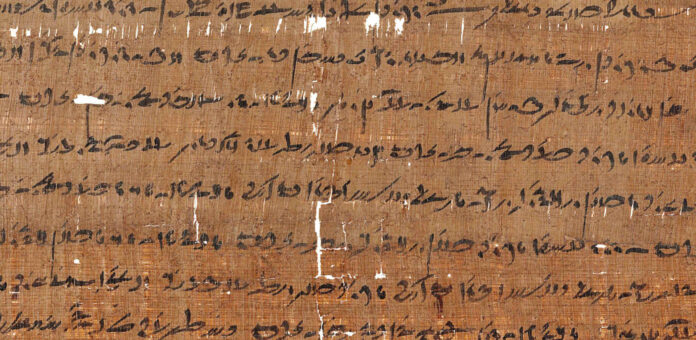Elephantine is an island on the Nile River in southern Egypt. This trade and border centre was home to a uniquely diverse population. Here, a whole range of languages, cultures and religions existed side by side. It is the only place in the world where 4,000 years of unbroken cultural history can be traced through written sources. Thousands of texts can be found on pieces of papyrus or clay shards written in ten different languages and scripts, including hieroglyphics, Aramaic, Coptic and Arabic. Today, they are held in 60 collections in 24 different countries, and have ben deciphered in a major European research project (ERC), before being translated and digitally catalogued. In this comprehensive, world-first exhibition, outstanding objects from Berlin’s collections will be shown alongside highlights from around the world. The diverse content of the texts will be contextualised with reference to archaeological finds and interpreted from a contemporary perspective, giving audiences a unique, first-hand experience of the island of Elephantine on the Museumsinsel Berlin. The Nile Island Elephantine can be experienced through the special exhibition on the Museumsinsel, presented in the James-Simon-Galerie and in the Neues Museum.
Berlin is home to one of the world’s largest collections of objects from Elephantine outside of the Musée du Louvre or the Brooklyn Museum, the two cooperation partners for this exhibition. The texts gathered here tell stories of pluralism, family, religion, trade, and medicine. What can we learn from Elephantine today? In dialogue with scholars from the Arab-German Young Academy of Sciences and Humanities (AGYA), a number of contemporary perspectives on Elephantine have been produced for this exhibition. The show also provides the chance to celebrate the 10th anniversary of the founding of the AGYA, marking a decade of successful German-Arab research collaborations and scholarly diplomacy. Researchers from 22 Arab countries and Germany have been engaging in joint, interdisciplinary research projects, seeking out approaches to solving global social challenges.
Time on Elephantine at the James-Simon-Galerie
The entire exhibition is trilingual, carried out in Arabic, English and German, and was put together in close collaboration with the Egyptian Ministry for Tourism and Antiquities. The first part of the exhibition located in the James-Simon-Galerie focuses on the notion of “time” on Elephantine. Taking in a broad span of time, the show will illustrate the full scale of 4,000 years of cultural history, allowing visitors to interact with Elephantine by way of seven thematic islands through which they can walk. From the third millennium BC through to the era after the Arab conquest, the sources displayed here tell of the diversity of social life on the island, of the religious beliefs of the people who lived there, as well as their scientific achievements, such as those in the field of medicine. Letters, contracts, birth certificates, tax receipts, or medical prescriptions offer unique insights into these areas.
At various activity stations, museumgoers get to interact with themes that continue to be of relevance today. Because Elephantine is a unique model of historical diversity that can teach us lessons for the present and the future. Following the principle of seeing, hearing, touching, and smelling, the materiality of the different textual media is made palpable to audiences through “touching stations”, while the senses are excited by a spice market and contemporary artists interpret the themes of the texts in their own ways: with a European scent artist and Egyptian DJs offering a unique experience of Elephantine through their compositions.
The Space of Elephantine at the Neues Museum
In the second part of the exhibition at the Neues Museum, the focus is on the “space” of Elephantine. A large model presents the island within its regional context. Behind the model is a papyrus thicket, offering visitors a hands-on experience with these objects of research. After a seven-year research project funded by a European Research Council Grant titled Localizing 4000 Years of Cultural History: Texts and Scripts from Elephantine Island in Egypt, for the first time, more than 10,000 papyri and ostraca from the island have been digitally unlocked by an international research team. This project is presented in an interactive fashion through elements such as a sprawling papyrus puzzle. It also presents the outcomes of interdisciplinary collaborations with mathematicians and physicists, whose work has made it possible to “virtually” delaminate the closed papyri and papyrus packages, making them legible for the first time in history.
Curatorial Team
The exhibition Elephantine: Island of the Millennia was curated by Verena Lepper, project director for Elephantine and curator of the Egyptian and Oriental papyrus collection of the Ägyptisches Museum, along with project curator Anke Weber and project coordinator Rebekka Pabst, in collaboration with Eid Mertah from the Egyptian Ministry for Tourism and Antiquities.
Accompanying Programme
The exhibition is accompanied by a diverse programme of education and outreach activities.
Exhibition Publication
The exhibition will be accompanied by a publication in German, English and Arabic, released by Kulturverlag Kadmos.
Media partners: ARTE, Der Tagesspiegel, and tipBerlin
Funded by the Federal Ministry of Education and Research (BMBF), the Federal State of Berlin and the Capital Cultural Fund
A special exhibition of the Ägyptisches Museum und Papyrussammlung – Staatliche Museen zu Berlin, in collaboration with the Arab-German Young Academy of Sciences and Humanities (AGYA)
Source : Museen zu Berlin














